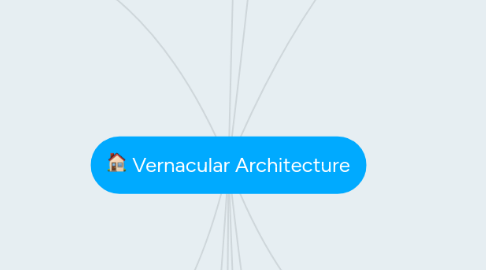
1. [3] Climate
1.1. Ventilation
1.2. Temperature
1.3. Light and Shadows
1.4. Humudity
1.5. Orientation
1.6. Topography
1.7. Forms and Building Types
1.7.1. Long Bamboo House
1.7.2. Loess Plateau
1.7.3. Courtyard Houses
1.7.4. Japanese Wooden Houses
1.7.5. Montane, Maritime
2. [4] Materials and Constructions
2.1. Natural materials
2.1.1. = non-manufactured materials
2.2. Local materials
2.3. Construction method and workmanship
2.3.1. passed down from generation to generation
2.3.2. Building Rituals and Dimensioning
2.3.2.1. Cosmo reasons
2.3.2.2. Fengshui
2.3.2.3. Human Scale
2.3.3. Reflecting cultural value
2.4. Tradition
2.4.1. Transmission of Knowledge
2.4.2. e.g. memorised "secret rhymes"
2.5. Structural Systems
3. [9] Conservation and Vernacular Heritage
3.1. Tangible values
3.1.1. Aesthetics/ Artistic value
3.1.2. Historical Value
3.1.3. Architectural values
3.2. Intangible values
3.2.1. Social/Cultural Significance
3.2.1.1. Change between Generations
3.2.1.2. Subjectivity
3.2.2. Spiritual
3.3. Economic Values
3.3.1. Non-market value
3.3.1.1. Existence?
3.3.2. Market value
3.3.2.1. Land price?
3.4. Ways and Methods
3.4.1. Revitalisation
3.4.1.1. Introducing new function/activities
3.4.2. Presetrvation of physical building
3.5. Threats
3.5.1. Homogenisation
3.5.2. Globalisation
3.5.3. Gentrification
3.6. E.g. Wo Cheong Pawn shop, "Wedding Card street"
3.7. Conservation is the art of controlling change." It's not about preventing change, it is about controlling and managing those changes. Retaining the cultural significance of a place is of fundamental importance and ensuring the place can continue its original function or continue to be used in a way what it compliments its heritage value.
4. [8] Informal Settlements
4.1. often are...
4.1.1. built by anonymous builders or architects
4.1.2. in outskirts of cities
4.1.3. illegal
4.2. not planned in advance
4.3. part of the natural process of migration to cities
4.4. Threats
4.4.1. government clearance
4.4.2. sanitation and hygienic reasons
4.5. on land either in public or private ownership (but not belonging to the people who are settling there)
4.6. How to support the residence?
4.6.1. provision of services, such as water, drainage, and electrical power
4.6.2. introducing new design to solve economic problems e.ge plug-in units
4.6.3. provide loans
4.7. exist mostly for historical, political, and social reasons,
4.8. E.g. Kowloon Walled City
4.8.1. political reasons
4.9. Construction Method
4.9.1. Piecemeal
5. [10] Future of Asia's Vernacular Architecture
5.1. No tradition without the modernity
5.2. Modernity includes vernacularity and tradition?
5.3. Tradition as a product AND process
6. [2] People and Culture
6.1. Culture
6.1.1. Embodies the complexity of distinctive spiritual, material, intellectual and emotional features that characterize a society or social group
6.1.2. The manner in which people build their habitats, and the ways they use the material and methods within their means, availability and limits
6.1.3. How they live, the ways people feel, the values they hold, and the tradition and beliefs they have
6.2. VA as "artefacts"
6.2.1. material culture
6.2.2. as a "window" to understand a particular culture
6.3. 3 Levels of Meaning
6.3.1. Low-level
6.3.1.1. social and privacy
6.3.1.2. accessibility
6.3.2. Middle-level
6.3.2.1. identity
6.3.2.2. status,wealth and power
6.3.3. High-level
6.3.3.1. cosmology
6.3.3.2. religions and beliefs
6.3.3.3. world views
6.3.3.4. philosophies
6.4. Genius Loci
6.5. Note: "Meaning" comes only from human beings. (i.e. Buildings themselves have no meaning yet meanings are what we impose on them)
6.6. Identity
6.6.1. Memories and Impression
6.6.2. Living style
6.6.3. Self-expression
6.6.4. Differentiating oneself from others
6.6.5. shaped by environment we live in
7. [5] Vernacular Landscape
7.1. Changing process
7.1.1. Transformation
7.1.2. Evolution
7.2. Timelessness
7.3. Sense of Place
7.3.1. Neighbourhood
7.3.2. The "spirit" of a place
7.4. Man-made/Cultural Landscape
7.5. Identity
7.6. Determined by both tangible and intangible features
7.7. Having been living in Tai Hang for 20 years, the community and atmosphere shaped by the mid-rise tenement buildings in the area really give me a strong sense of belongings and identity. I think that's an example of vernacular landscape.
8. [1] What is Vernacular Architecture? (Definitions)
8.1. The building that's most likely to be built in a particular place, at a particular time
8.2. Continuing process including necessary changes
8.2.1. adapt to changes through TIME
8.2.2. continuous adaptation as a response to social and environmental constraints
8.3. Process of transmission of knowledge
8.3.1. Passed down from generation to generation
8.3.1.1. becoming a tradition/culture
8.3.2. Commonly shared and understood knowledge
8.4. Indigeneity
8.4.1. Indigenous by the non-indigenous
8.4.2. the traditional and natural way by which communities house themselves
8.4.3. Everyday built environment in which people live in
8.5. Local and regional dialect
8.5.1. Fundamental expression of the culture of a community, of its relationship with its territory
8.6. Generally VA are...
8.6.1. in recognisable building forms and appearance
8.6.2. put together with community effort and common materials
8.6.3. defining a community's identity
8.7. Vernacular Architecture does NOT necessarily equal to "architecture without architects", yet it includes ordinary buildings and landscapes made by what we call professional architects/builders
9. [6] Rural Vernacular
9.1. Settlement
9.1.1. = place people establish a community
9.2. Setting
9.2.1. = place where people embedded (cultural landscape)
9.3. village contexts
9.4. materials
9.4.1. based on accessibility of resources
9.4.2. necessity (climate and culture etc.)
9.4.3. passed down knowledge and construction method
9.4.4. proverty
9.5. Examples
9.5.1. Diaolous
9.6. Self-consciousness?
10. [7] Urban Vernacular
10.1. Urbanization
10.1.1. economical reasons mainly
10.2. Cultural milieu
10.2.1. cultural diversity
10.3. Evolve over time as culture and economy change
10.3.1. determining building method and materials
10.4. Typologies
10.4.1. Japanese townhouse
10.4.2. South Asian bungalow
10.4.3. Asian shop houses
10.4.4. Urban houses in Kathmandu Valley
